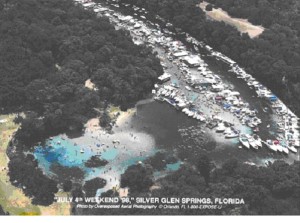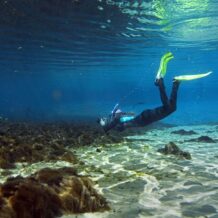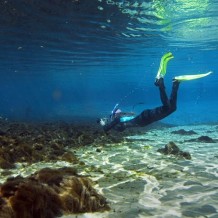health and science
Silver Glen Springs
Silver Glen Springs is a very popular recreation area which has suffered from overuse and misuse. The degradation of the spring and run has been apparent for years and by the late 1990’s had caught the attention of Tallahassee. That’s when Jim Stevenson of the FDEP gave me a call saying he needed photos of damage to the vegetation in the spring. So, I headed over to Silver Glen with my waterproof camera to document conditions for him.
I found that the area around the head spring had lost most of its eelgrass beds to trampling by bathers, and was mostly reduced to a bare white sand bottom. In stark contrast, the short run leading to the Natural Well Spring, which was off-limits to bathers, had as lush a stand of eelgrass as I have ever seen.
I then moved downstream, beyond the rope designating the swimming area, and into the run. It was a beautiful summer afternoon and there were scores of boats anchored for several hundred feet down the run. It was the typical party scene for which the spring has become famous.
Folks were in their boats and in the water, socializing against a background of beautiful swamp forest and blaring radios. I waded among the crowd taking underwater photos of eelgrass damaged by props, anchors, and feet, as well as recently uprooted plants drifting in the current. In fact, I observed one bather actively pulling up eelgrass in a misguided effort to improve the wading area. I am sure this was no isolated action. Many waterfront homeowners relentlessly remove shallow water plants and are hostile to education programs and regulations that attempt to protect this important vegetation zone. Plants that happen to be underwater seem to be vaguely threatening to many people, who are more comfortable in a swimming pool–like environment.
I must admit to a certain degree of self-consciousness, and I kept a low profile as I moved among the throng with my camera. Everyone was super friendly, but they did not know what I was up to. Later, I paddled my canoe to the mouth of the run, where several large cigarette-type boats were tied up. There I overheard one of the captains say “Look at that poor guy in that little boat. I sure feel sorry for him”. Of course, that comment made me bristle, and I almost said “Don’t feel sorry for me you dumb____, I’m here to shut this party down”. But, my unspoken reply was just an over-reaction, and the party continues to this day.
Presently, the FDEP hired an environmental consulting company in Gainesville, Pandion Systems, Inc., to study recreational impacts. They submitted a report to Jim Stevenson in 2002, called “Carrying Capacity Study of Silver Glen Spring and Run”.
Their detailed findings agreed with the casual observations I had made a few years earlier.
Pandion reported that waders caused considerable damage to vegetation by trampling, especially where they access the spring from the Forest Service visitor area, and in the open sand area downstream of the roped swimming area, where boaters like to anchor and get in the water.
They also found that almost all the 200 x 3300 foot run suffered some sort of boat related harm, including mechanical damage to submerged vegetation by propeller impacts, and drag marks and pits from anchors. This is still happening. Look on the internet and you will find accounts of attempts to get large deep draft boats up the run. They describe hitting the bottom, grinding their way up the run with their props in the sediments, and even grounding and having to call a towing service. However, it is fair to say that more thoughtful boaters carefully pick their path up the run, or make a point of anchoring their boats in the deeper water of the lake and take their small dingies up the run. However, many boaters will not anchor in the lake because of uneasiness over wind, waves and alligators. They naturally enough prefer the protected waters of the run.
To get more specific about the conditions in the spring, Pandion found that rooted submerged aquatic vegetation (SAV) covered 31%, or about 7 acres of the 22 acre SilverGlenSpring and run. For the reader with a botanical bent, the SAV species included: Vallisneria americana (eelgrass), Myriophyllum spp (water milfoils), Hydrilla verticillata (hydrilla), Eleocharis spp (spikerushes), Ceratophyllum spp (coontails), and Sagittaria kurziana (strap-leaf sagittaria).
Unfortunately, the non-native, invasive hydrilla was present in about 20% (4.5 acres) of the run, and was noted as the dominant species in about 5% (1 acre). Pandion felt that hydrilla was a major concern due to its ability to spread rapidly and out-compete native vegetation. Filamentous algal mats, a relatively recent problem at the spring, were dominant in about 7% (1.5 acres) of the run. In some of these areas the investigators found it in large, dense mats that were sometimes more than 2 feet thick.
On a positive note, Pandion measured rapid growth of vegetation in cages placed in the run. (The cages protected vegetation from trampling and boat impacts.) This indicated that, with protection, vegetation in the run could regenerate fairly quickly. However, the recent phenomenon of explosive filamentous algae growth, which can smother native plants, could confound recovery efforts.
Pandion concluded that if the current pattern of use continues without any intervention, Silver Glen is in serious peril, and that active management combined with ecosystem monitoring is needed to restore the ecology of Silver Glen.
The carrying capacity study and successful intervention undertaken at IchetuckneeSpringsState Park has been held up as a model for what could be done at Silver Glen. Small changes at the Itch, such as daily number limits on tubers, better facilities at access points, and the establishment of protected areas, has largely restored a once seriously degraded spring and run.
However, attempts to control boater impacts at Silver Glen have met with strong and organized resistance. There is a web-based group, ironically named “Friends of Silver Glen”, whose stated purpose is “to save and preserve all boaters’ traditional and historic access to SilverGlenSprings”. Their concerns do not seem to include eelgrass. Visit their site at: http://silverglen.2sdaze.com/
The US Fish and Wildlife Service (USFWS) has declared Silver Glen to be a “critical habitat” for the endangered West Indian manatee. This is largely based on the fact that manatees need a warm water refuge during the winter months, when temperatures in the St. Johns River fall to lethal levels. Several hundred manatees now overwinter upstream at Blue Spring in VolusiaCounty. This seems a little crowded to me, and it might be a good thing if they had another spot to hang out for the winter.
Attempts to cordon off parts of the run for vegetation regeneration and manatee protection have alarmed boaters. They believe this is a “slippery slope”, the first step in permanently banning boats from the spring run, even though the USFS has repeatedly denied this intent. They are sure that if the manatees come, the boaters must go, and I suppose there could be some truth to this, at least in the winter months. But, are seasonal limits too much to ask of the boaters, especially since the overwintering season for the manatees does not coincide with the peak summer boating season at Silver Glen?
An unusually large number of government entities are involved in the management of Silver Glen. The Florida Fish and Wildlife Conservation Commission (FFWCC) monitors boat traffic and safety. The Florida Department of Environmental Protection (FDEP) has jurisdiction over sovereign submerged lands and waterways. The U.S. Fish and Wildlife Service (USFWS) has designated Silver Glen as a critical habitat for manatees. And the spring is in the OcalaNational Forest, which is managed by the United States Forest Service (USFS). Generally, the state of Florida has jurisdiction over the state’s waterways, but because SilverGlenSprings is on the eastern edge of the Forest, the USFS has concurrent jurisdiction. Finally, the spring is shared by both Marion and LakeCounties, who patrol for alcohol violations and other forbidden behavior.
In light of the critical manatee habitat designation, some people have asked me why the USFWS does not just declare the run off limits to motorboats. I do not know the answer to this, but it appears that the USFWS and other agencies are reluctant to manage the spring in too heavy-handed a manner. But the boaters need to do their part. One boating organization, aware of their possibly precarious position, has posted a list of do’s and don’ts. It includes little things like not dumping sewage overboard, tying up properly using the new anchor buoy system, and cooling the public drunkenness. One can only hope more boaters follow their suggestions.
Algae
Healthy Florida springs are known for their luxuriant growth of eelgrass and other aquatic vegetation, and ecological studies have shown that the conditions in our springs favor some of the highest rates of plant growth in the world: extremely clear water allows maximum sunlight penetration; heat and cold stresses are nonexistent in the stable water temperatures; strong currents keep plant surfaces clean and carry away metabolic wastes; and the constant supply of fresh groundwater brings valuable dissolved nutrients and gasses to the plants.
It is not just the big plants, the so-called macrophytes, which supply the energy that supports the huge variety and biomass of wildlife common to springs. Tiny diatoms and other algae that encrust the leaves of the macrophytes, the periphyton, are photosynthetic powerhouses, and contribute to spring productivity far out of proportion to their microscopic size.
By the 1990’s, another type of algae, which was always around in small amounts, began to catch our attention. Filamentous algae began to cover sand bottoms, bare rock surfaces, and native plants in our springs. A decade later algae has come to dominate large parts of these ecosystems, often smothering and killing native vegetation.
Plants need sunlight, water, and nutrients to grow. Our springs have always been blessed with an abundance of the first two ingredients, but nutrient levels in springs were, historically, very low. However, our expanding population and cultural practices, such as fertilizer use, has changed that, and our aquifers and springs now suffer from widespread nutrient pollution, especially by nitrates. The explosive growth of filamentous algae coincided with aquifer pollution, and nitrates took the lion’s share of blame for the runaway growth. Undoubtedly, nitrates play a huge role in the statewide algae problem, but the algae story at Silver Glen suggests that the story may not be as simple as nitrate pollution.
The Silver Glen springshed is mostly within the Ocala National Forest where fertilizer use and other human sources of nutrients are limited. Consequently, nitrate and other nutrient levels in SilverGlenSprings are still at historically low levels. But Silver Glen has a huge filamentous algae problem. So, what is going on?
Well, no one really knows. One theory holds that destruction of native vegetation opens the door for runaway algal growth. But, the smothering and near elimination of the healthy eelgrass in the Natural Well area, where bathers are not allowed and the eelgrass has not been battered by bare feet, suggests this is not the case.
Another theory suggests that we have pumped so much water off the top of the aquifer, where the best water is found, that there has been an increase in older, more mineralized and oxygen poor water discharging from the spring. Allegedly, this has caused a decrease in animals that graze algae, particularly snails, causing an increase in algae. Investigators are still working on this one, but it has not gained a large following.
Still another theory holds that several of the troublesome algae, such as Lyngbya sp. (sorry, no common name), may be recently introduced exotic species that are undergoing a runaway growth phase. Who knows, but Lyngbya was absent from Silver Springs in the 1950’s and is now a huge problem there.
Whatever the reason, filamentous algae is in Silver Glen. It is kicked out of the head spring and upper run in the summer by swimmers, but builds up to unsightly levels in the winter. It has killed the eelgrass in the Natural Well, and smothers vegetation in the run. Furthermore, some people are sensitive to the algae and develop rashes, respiratory problems, and stomach ailments. Finally, when the brownish algae covers the bottom, it changes the spring’s absorptive, refractive, and reflective characteristics, and the Glen is not quite so silver, not quite so exquisite.






